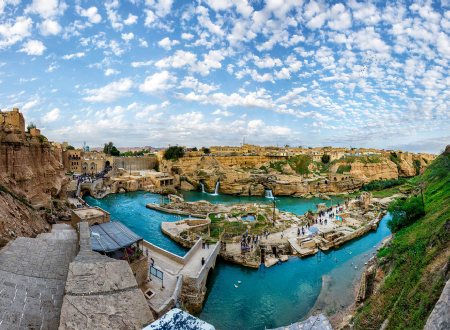The Shooshtar Waterfalls (Shushtar Historical Hydraulic System) are considered to be an attractive historical site. They are located alongside a branch of the Gerger (Gar Gar River), near Sika. It was registered on UNESCO's list of World Heritage Sites in 2009 and is Iran's 10th cultural heritage site to be registered on the United Nations' list.
Parts of the irrigation system are said to originally date to the time of Darius the Great, an Achaemenian king of Iran. It partly consists of a pair of primary diversion canals in the Karun river, one of which is still in use today. It delivers water to the Shushtar city via a route of supplying tunnels. The area includes Salasel Castel, which is the axis for operation of the hydraulic system. It also consists of a tower for water level measurement, along with bridges, dams, mills, and basins.
These ancient waterfalls were constructed in the year 1233 AH, in order to protect the
Mizan Dam. In the same year in order to prevent the destruction of the dam, another dike was constructed. Thence outlets of the
Mizan Dam was blocked and the course of Gargar River dried up.
The Gargar Dam was also constructed on the course of this river and some holes were constructed on the top of this dam, between the two scarps of the river overlooking the valley of Gargar River in the midst of the rocks in order to conduct the water to flow through the holes, thus creating the present waterfalls. In this way the probability of the destruction of dam decreased.
Since the construction of the Koohrang Tunnel which transfers the water from the Karoon to the
Zayandeh Rood River, and with the construction of Shahid Abbaspour Dam, the flow of the waterfalls have considerably decreased. But need less to say that these waterfalls are still interesting and wonderful, and account for as one of the most important attractive sites of
Shooshtar city.


